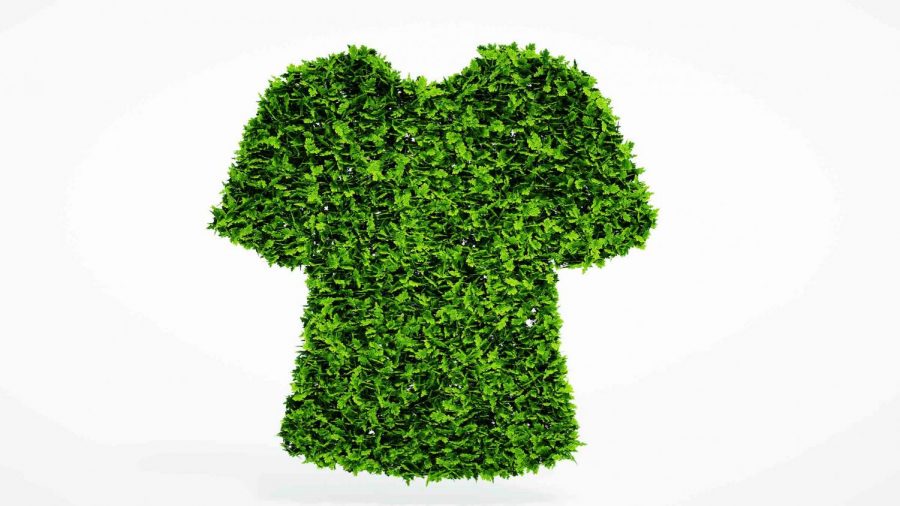A Guide to Sustainable Fashion
How You Can Avoid Killing the Planet
March 5, 2019
Take a right out of the student parking lot, drive down McKnight road for around six miles, and you will find yourself at Ross Park Mall. I am sure we are all familiar with what you can find there — from the latest fashion trends to the best food court around, you will find something. There is one thing you won’t find there, though: sustainability.
Some background: I grew up in a house of travelers and lovers of nature, so naturally, I live my life similarly. I also grew up having only been exposed to the idea that when a piece of clothing no longer fits or does not suit your style anymore, you donate it. Apparently, this was not the case for many others. It was just recently that I dove into the depths of what it is to dress sustainably and the true meanings of ethics in fashion branding, thus beginning my frustrations with how much influence we have on the planet and those living on it without even knowing.
When you drive those few miles and buy the newest top that just became trendy, you support brands of fast fashion who source from textile workshops that pay their employees little to nothing, which can put them in extreme danger depending on the work environment and conditions. A documentary that was recently played after school for the students of NASH, The True Cost, discusses which brands source from dangerous textile plants that most likely include some of your favorite brands: American Eagle Outfitters, Forever 21, and H&M. These companies are some of the worst competitors in this race against the never-ending trends to which our generation has taken a liking.
The reason the industry of fast fashion is so dangerous, other than the work environment for the employees creating these pieces, is the impact that it has on the ecosystem before and after it becomes a brief part of your wardrobe. Before you put it on, before you even purchase it, the path the article takes leaves a huge impact on the environment. Once a piece of clothing is finished being created, there are tons — literal tons — of leftover fabric. These leftover textiles end up thrown away and find themselves in landfills and oceans around the world. And once the clothing article goes out of style, or it doesn’t fit you anymore, what do you do to get it out of your life?
With nearly 100% of textiles and clothing being recyclable, the answer seems simple. Take the pieces to either a consignment shop or donation center, and be done with it. But I have come to learn that even with these options, there are still those who just throw away the clothing. The issue with simply putting unwanted clothing in the garbage is where it ends ups. The United States alone sends 85% of leftover textiles and clothing to landfills. Not only does the product end up in landfills, but it also ends up in the ocean, further polluting the planet.
To get more information, I asked the president of NASH’s own fashion club, Parastoo Aramesh, and the club sponsor as well as incredible FCS teacher, Mrs. Gallagher, about what sustainability importance is in fashion and why they each think it is important discuss, especially to high school students. Here’s what they had to say:
Parastoo: “When thinking about going into the fashion industry, it’s important to know that it’s more than just making beautiful clothes for elegant runways and that we need to be conscious of all the labor put into it and the environmental impact it produces. When we watch a runway show or buy new clothes at stores, we don’t usually think about those who sewed it, their work conditions, income, or the impact its very production has on the environment. So, it’s important to be reminded of all that goes on behind the scenes.”
Mrs. Gallagher: “Sustainability in fashion is an important issue for all consumers, from both the environmental impact of the industry as well as the human rights injustices the people who make our clothing suffer. When ‘fast fashion’ is the business model, companies strive to reduce costs as low as possible; often the people who pay the price are the individuals making our clothing in overseas factories. Due to the economic conditions in the countries in which these factories are located, these workers have little choice to leave this job for better opportunities. In addition, with constantly evolving, inexpensive clothing, the waste generated from clothing that is no longer needed is overwhelming. The waste, not only from consumers discarding unwanted clothing, but also from the carbon footprint of shipping clothing all over the world before it reaches the store, makes the fashion industry one of the most polluting industries on earth. It’s important for students in high school to understand that their decisions as consumers directly impact the fashion industry, and as a result, directly impact the environment and social justice issues.”
The solutions to this issue plaguing our ever-evolving society are quite straightforward. The initial step towards living more sustainably within fashion is buying what you need and knowing you will wear it for yourself rather than for the latest trends. It is much easier said than done, even when it seems like such a mindless task. Now, I can admit it can be an extreme challenge not to buy from Forever 21, especially with how on-trend they are and with their low prices. But, if you have pieces you love, even if they are from less than perfect brands, you can keep them while maintaining their worth by simply repairing them at the times of rips. It’s surprisingly easy to pick up a needle and thread and patch a little tear, especially when we have YouTube at our fingertips. And if you still have the urge to spend, there are so many incredible brands to shop with fair trade, ethical fabrics, and sustainable pieces with economically friendly production. From high-end Reformation with “to die” for pieces, to simplicity and affordability through the company Everlane, the options are truly endless.
While choosing to live sustainably, even if just through physical expression, can be quite pricey, it’s about what’s worth most to you. It comes down to a simple question. Would you rather spend less on a lower quality item, in turn harming the planet and those on it, or spend a little more for great quality and brands you can trust? Our impact is greater than simply wearing the “hottest looks” in class; we are impacting the rest of the world for the rest of our lives.












